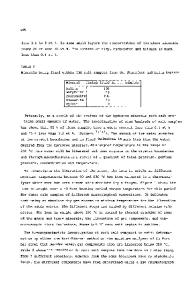Computations of Temperature Profiles in the Medium/Low-level Waste Cement and in the Rock Salt Surrounding the Disposal
- PDF / 324,359 Bytes
- 8 Pages / 420.48 x 639 pts Page_size
- 56 Downloads / 294 Views
Werner. Lute, editor
COMPUTATIONS
OF TEMPERATURE PROFILES IN THE MEDIUM/LOWaLEVEL
WASTE CEMENT AND IN THE ROCK SALT SURROUNDING THE DISPOSAL CAVERN W. HAUSER, E. SMAILOS, R. KOSTER Kernforschungszentrum Karlsruhe GmbH., Institut fQr Nukleare Entsorgungstechnik, Postfach 3640, D-7500 Karlsruhe, Federal Republic of Germany
INTRODUCTION Prior to disposal of cemented medium level waste and low level waste in large caverns 1000 m below ground it is important to 1.
know what temperatures will be caused by heat generation in waste product.
the
During the disposal period the heat produced by hy-
dration of the cement used as the binder as well as by decaying radionuclides in ratures in
the waste may give rise to inadmissibly high tempea deterioration of the
the waste product resulting in
produc:t qualities.
To avoid such undesirable processes,
permissible product temperature vestigations,
i.e.
of 90°C was specified
significantly below the
a temperature that is
boiling point of the water contained in
a maximum
for the in-
the cemented product.
Earlier investigations have shown that temperatures occur in the salt cavern during disposal and fixation of a cemented waste suspension which are well above this maximum acceptable temperature.
The fixation of the liquid wastes in
release their heat of hydration already
posal of a granule/grout product results in setting in
cement granules which
above ground,
and the dis-
temperatures during
the cavern which are significantly below 900 C /i/.
This has been terature data,
shown by one-dimensional
calculations,
based on li-
for the hydration heat of the cements used.
In the investigations discussed in this paper, a three-dimensional computer program was employed using experimentally determined data on the heat generation of the granule/grout product. tion,
this made it
the waste product as well as in 2.
In
addi-
possible to calculate temperature profiles in the surrounding rock salt.
DESCRIPTION OF THE MODEL OF CALCULATION
2.1 HEAT SOURCES IN THE IN-SITU WASTE PRODUCT For calculating the temperatures in
the cavern and in
the sur-
860 rounding
source sides heat
rock which undergo
salt
dependent
heat power
to be
taken
into
the decay heat of hydration
was determined
account in
time,
the computation
of radionuclides
resulting
by
with
variations
the time
of the waste product must be known.
contained in
from cement setting.
calorimetric
measurements
model is,
be-
the waste,
This
made
The heat
the
variable
on an in-situ
re-
ference product. The investigations
have
the development with bed mathematically teristic the
time
in
that
in
decay
Q0.
heat power
the process heat 0(t)
of the hydration
good approximation
of radioactive initial
revealed
such as
Accordingly
of setting
can be
by the parameters
the decay
constant
descricharac-
A and
the following equation
app-
lies:
(t) Fig. in-situ
1 shows
=
Qo
exp
(-A't)
the development with time
waste product /2/
made
of the heat power. of t
Data Loading...











